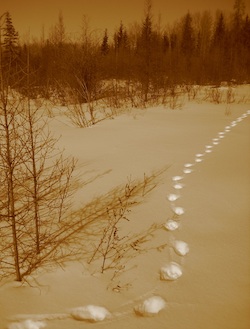
A new study shows that counting animal tracks – like these from a rarely-seen Canada lynx – can provide an accurate estimate of how many individuals are in a given area. (Photo credit: Derek Keeping)
A new computer analysis shows that animal tracks can provide an accurate estimate of animal populations in a given area. Biologists often use animal tracks for relative estimates – e.g. more over here than over there – but because tracks can twist and turn, they shy away from using them to get an absolute number of animals per area.
A computer simulation of ‘virtual animals’ has validated an older Russian hypothesis, showing that there is a direct relationship between tracks and population that doesn’t depend on how convoluted the trackways are. This means that tracks can safely be used to estimate numbers of hard-to-find animals, offering a new tool for conservationists.
Original research paper published in the the journal PLOS ONE on May 28, 2014.
Names and affiliations of selected authors


